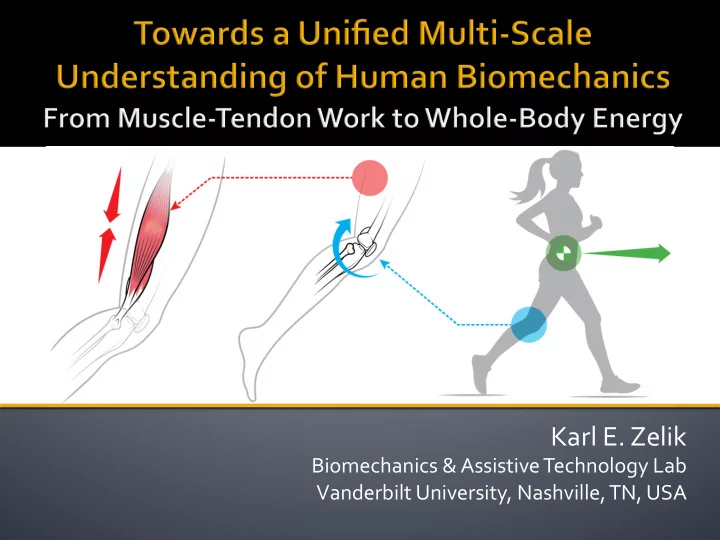

Karl%E.%Zelik % Biomechanics%&%Assistive%Technology%Lab % Vanderbilt%University,%Nashville,%TN,%USA %
Mathematics (Base 10 Blocks) 10x 1x 100x = =
Currency 100x 10x 1x = =
Experimental Biomechanics - Grand Challenge WHOLE-BODY
Experimental Biomechanics - Grand Challenge JOINT-SEGMENT WHOLE-BODY
Experimental Biomechanics - Grand Challenge MUSCLE-TENDON JOINT-SEGMENT WHOLE-BODY
Neuromechanics - Even Grander Challenge
5 Gaps & Challenges MUSCLE-TENDON JOINT-SEGMENT WHOLE-BODY 2 1 5 3 4
Hodgepodge of Thoughts on Multi-Scale Biomechanics MUSCLE-TENDON JOINT-SEGMENT WHOLE-BODY 2 1 5 3 4
Whole-Body 5
5 Whole-Body Center-of-Mass (COM) energy change (estimated from force plates)
Whole-Body 5 Center-of-Mass (COM) energy change (estimated from force plates) + Peripheral energy change (motion relative to COM)
Whole-Body ! Mostly Resolved 5 Trust whole-body mechanics b/c they add up properly
Whole-Body ! Mostly Resolved 5 Trust whole-body mechanics b/c they add up properly
Whole-Body ! Mostly Resolved 5 Trust whole-body mechanics b/c they add up properly Zelik & Kuo 2010; Zelik, Takahashi & Sawicki 2015
Whole-Body ! Mostly Resolved 5 Trust whole-body mechanics b/c they add up properly Zelik & Kuo 2010; Zelik, Takahashi & Sawicki 2015
4 Joint-Segment vs. Whole-Body
4 Joint-Segment vs. Whole-Body Whole-Body Energy Change
4 Joint-Segment vs. Whole-Body Whole-Body Energy Change
4 Joint-Segment vs. Whole-Body walking at 1.4 m/s
4 Joint-Segment vs. Whole-Body Joint-Segment Work
4 Joint-Segment vs. Whole-Body Inverse Dynamics Joint-Segment Work
4 Joint-Segment vs. Whole-Body Joint-Segment Work
4 Joint-Segment vs. Whole-Body Joint-Segment Work
4 Joint-Segment vs. Whole-Body walking at 1.4 m/s
Joint-Segment vs. Whole-Body ! Partly Resolved 4 3DOF joint-segment work fails to explain whole-body energy Zelik, Takahashi & Sawicki 2015
Joint-Segment vs. Whole-Body ! Partly Resolved 4 6DOF joint-segment work explains whole-body energy but commonly-used 3DOF analysis does not Zelik, Takahashi & Sawicki 2015
Joint-Segment vs. Whole-Body ! Partly Resolved 4 6DOF joint-segment work explains whole-body energy but commonly-used 3DOF analysis does not 6DOF inverse dynamics How much work to move body segments? rotational work + translational work Buczek 1994, Duncan 1997
3 Joint-Segment
3 Joint-Segment estimates still miss negative soft tissue work
Joint-Segment ! Partly Resolved, But Concerning 3 Reasonable estimates, but soft tissues & feet usually neglected though they perform substantial work Fu, Zelik, Board, Browning & Kuo 2015
Joint-Segment ! Partly Resolved, But Concerning 3 Reasonable estimates, but soft tissues & feet usually neglected though they perform substantial work Fu, Zelik, Board, Browning & Kuo 2015
2 Muscle-Tendon vs. Joint-Segment 5
Muscle-Tendon vs. Joint-Segment ! Unknown 2 Consistency hard to assess 5
Muscle-Tendon vs. Joint-Segment ! Unknown 2 Consistency hard to assess, but anecdotal evidence of problem What is mechanical function of foot during push-off in walking or running? Ker et al. 1987 Stearne et al. 2016 Acts like a spring! 5
Muscle-Tendon vs. Joint-Segment ! Unknown 2 Consistency hard to assess, but anecdotal evidence of problem What is mechanical function of foot during push-off in walking or running? Ker et al. 1987 Stefanyshyn & Nigg 1997 Stearne et al. 2016 Takahashi & Stanhope 2013 Acts like a spring! Acts like a damper! 5
Muscle-Tendon vs. Joint-Segment ! Unknown 2 Consistency hard to assess, but anecdotal evidence of problem Potential approach: data-driven musculoskeletal modeling 5 Honert & Zelik, In Review
Muscle-Tendon vs. Joint-Segment ! Unknown 2 Consistency hard to assess, but anecdotal evidence of problem Potential approach: data-driven musculoskeletal modeling 5 Honert & Zelik, In Review
1 Muscle-Tendon 5
1 Muscle-Tendon 5
Muscle-Tendon ! Troubling 1 Net positive work by passive tendons indicates a problem some current estimates indicate tendons act like motors Sakuma et al. 2012
Muscle-Tendon ! Troubling 1 Net positive work by passive tendons indicates a problem some current estimates indicate tendons act like motors Sakuma et al. 2012
Muscle-Tendon ! Troubling 1 Net positive work by passive tendons indicates a problem some current estimates indicate tendons act like motors
Muscle-Tendon ! Troubling 1 Net positive work by passive tendons indicates a problem some current estimates indicate tendons act like motors tendon elastically storing energy
Muscle-Tendon ! Troubling 1 Net positive work by passive tendons indicates a problem some current estimates indicate tendons act like motors returning 2x tendon more energy elastically storing energy
2 1 5 3 4 Funding:( NIH,%NSF,%Whitaker%International % % % my.vanderbilt.edu/batlab (
Recommend
More recommend